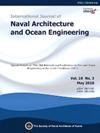Numerical analysis of water management and reactant distribution in PEM fuel cells with a convergent 5-channel serpentine flow field for emission-free ships
IF 3.9
3区 工程技术
Q2 ENGINEERING, MARINE
International Journal of Naval Architecture and Ocean Engineering
Pub Date : 2025-01-01
DOI:10.1016/j.ijnaoe.2025.100649
引用次数: 0
Abstract
Polymer Electrolyte Membrane Fuel Cells (PEMFCs) represent a promising energy solution for the marine industry, facilitating a sustainable transition from fossil fuels to emission-free alternatives. Despite their high power density and efficiency, water management is an issue. The serpentine flow channel (SFC) design is known for its efficient reactant distribution and enhanced water removal due to high-pressure drops when certain design conditions are met. Regardless these channels exhibit drawbacks such as increased flow resistance due to extended lengths and sharp bends, alongside non-uniform reactant distribution near the channels. This study develops a multiphase three-dimensional model to simulate the transport of mass, species and water within a PEMFC equipped with a five-channel SFC. The simulation results are validated through experiments and compared with two novel convergent 5-channel serpentines. The newly proposed convergent five-channel SFCs demonstrated improved performance at high current densities, notably in power density, pressure drop, water distribution, and removal.
无排放船舶5通道蛇形流场PEM燃料电池水管理及反应物分布数值分析
聚合物电解质膜燃料电池(pemfc)代表了海洋工业一种有前途的能源解决方案,促进了从化石燃料到零排放替代品的可持续过渡。尽管它们的功率密度和效率很高,但水管理是一个问题。蛇形流道(SFC)设计以其高效的反应物分布和在满足一定设计条件时由于高压降而增强的除水能力而闻名。然而,这些通道也存在一些缺点,如由于长度延长和急转弯而增加的流动阻力,以及通道附近的反应物分布不均匀。本研究建立了一个多相三维模型来模拟装有五通道SFC的PEMFC内的质量、物种和水的输运,并通过实验验证了模拟结果,并与两种新型收敛的五通道蛇形体进行了比较。新提出的会聚五通道sfc在高电流密度下表现出更好的性能,特别是在功率密度、压降、水分布和去除方面。
本文章由计算机程序翻译,如有差异,请以英文原文为准。
求助全文
约1分钟内获得全文
求助全文
来源期刊

International Journal of Naval Architecture and Ocean Engineering
ENGINEERING, MARINE-
CiteScore
4.90
自引率
4.50%
发文量
62
审稿时长
12 months
期刊介绍:
International Journal of Naval Architecture and Ocean Engineering provides a forum for engineers and scientists from a wide range of disciplines to present and discuss various phenomena in the utilization and preservation of ocean environment. Without being limited by the traditional categorization, it is encouraged to present advanced technology development and scientific research, as long as they are aimed for more and better human engagement with ocean environment. Topics include, but not limited to: marine hydrodynamics; structural mechanics; marine propulsion system; design methodology & practice; production technology; system dynamics & control; marine equipment technology; materials science; underwater acoustics; ocean remote sensing; and information technology related to ship and marine systems; ocean energy systems; marine environmental engineering; maritime safety engineering; polar & arctic engineering; coastal & port engineering; subsea engineering; and specialized watercraft engineering.
 求助内容:
求助内容: 应助结果提醒方式:
应助结果提醒方式:


